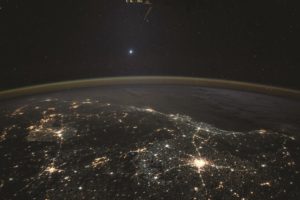After a long absence, Venus has returned as the brilliant Evening Star. It spent some time this winter toughing it out in the frigid predawn sky in its other guise as the Morning Star. Then, it hid on the opposite side of the Sun, where we couldn’t see it at all. Now, it has emerged from the Sun’s glare and shines brightly in the west at sunset.
When I wrote about Venus a year ago, I noted the planet’s physical characteristics (extremely unpleasant) and its prospects for fostering life (slim). But in September 2020, a team of scientists reported detecting phosphine gas in the atmosphere of Venus. This was astonishing news. Phosphine is a potential biosignature: a substance whose presence might indicate the presence of life.
If alien scientists were to observe Earth from a great distance using spectroscopy, as the Earthling scientists did with Venus, the molecular oxygen (O2) in our atmosphere would be a strong biosignature. Oxygen is highly reactive and quickly forms compounds with other atoms or molecules. With so much of it in our atmosphere (21 percent of the air we breathe is O2; 78 percent is nitrogen; the remaining 1 percent is other gases, including CO2), the aliens would know that something must be actively replenishing that oxygen. The most plausible hypothesis would be life.
The next time you swim in the bay or ocean, take a moment to thank the plankton surrounding you. They’re too small to see, but they produce 50 to 80 percent of our oxygen. Trees and other plants create the rest.
But back to Venus. Both biotic processes (resulting from living things) and abiotic processes (not from living things) can create phosphine. Given what we knew of the conditions and chemistry of Venus, no abiotic sources could account for the phosphine. Did that mean that some kind of Venusian life was responsible? Possibly. But important questions and doubts remained. Maybe there were abiotic sources we didn’t know about. Or anomalies in the data. Or errors in the analysis. The work went on.
In January 2021, the same team announced that there had, in fact, been an error in the calibration of the data. After a new analysis, the phosphine was still there, though not at levels as high as were originally reported. The work goes on.

While scientists pore over spectra, we can enjoy the visual spectacle. Any bay beach or harbor that faces west is perfect for viewing. Get there at sunset and look west. You’ll see a bright star, low in the west, following after the Sun. That’s Venus. You can’t miss its brilliant blue-white light.
And there’s more. In late April and through May, you’ll see a fainter star just above Venus, also in line with the setting sun. That’s little Mercury. On May 28, Venus and Mercury reach conjunction, when they are closest together from our point of view. Mercury will appear so close to Venus that it will probably be lost in the brighter planet’s glare to the unaided eye. Try viewing through binoculars, if you can. It’s worth the effort. They won’t be this close again until 2033.
Some ancient cultures, or at least their astronomers, realized that the Morning and Evening stars were the same object. Others did not. Venus does seem to take on a different character in each of its two roles. As the Morning Star — or as the Romans called it, Lucifer, the Light-Bringer — it heralds the rising sun and the daylight to come. But as the Evening Star — Vesper, to the Romans — it amplifies the beauty of the other stars and celebrates the night in a way that suggests the joys of the summer evenings ahead.
Clear skies!



